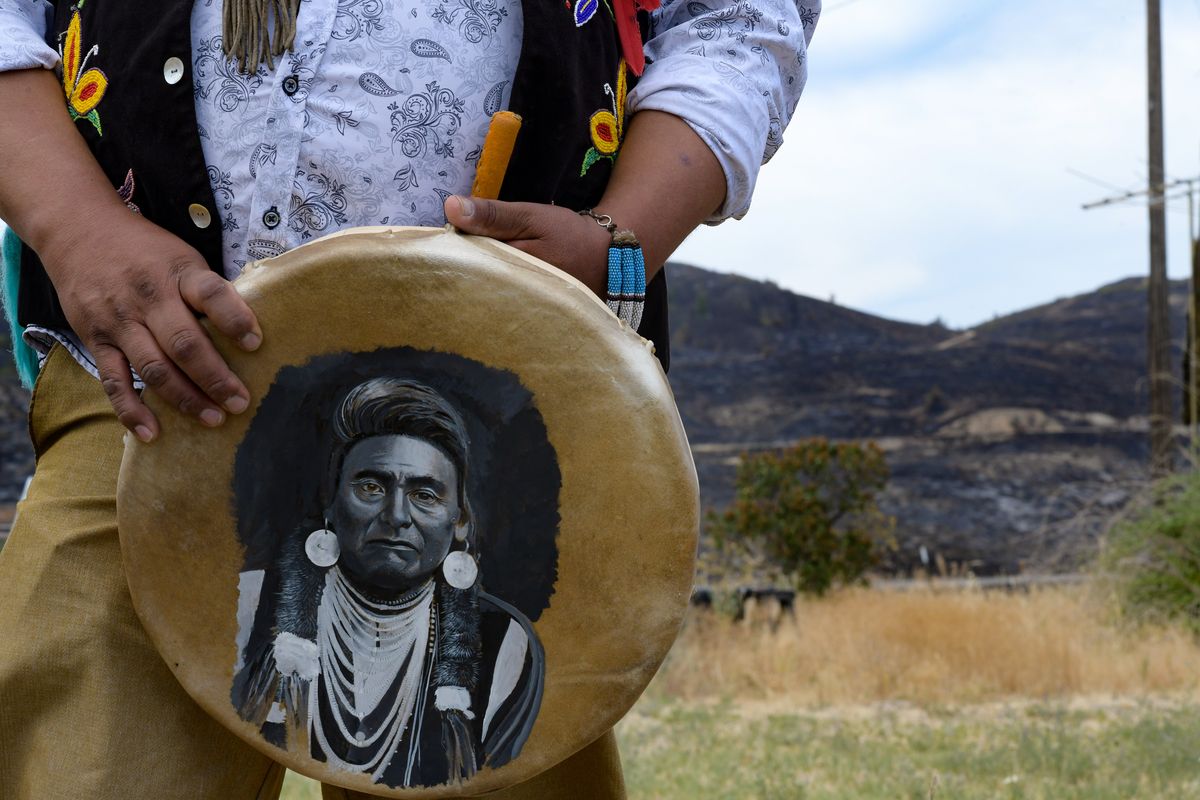As fires roar through its hills and forests, once again the Colville tribe watches its ‘life’s blood burn’

NESPELEM, Wash. – Lean and weathered, a horseman by trade who has broken his shoulders twice riding broncs and racing, Ralph Moses is Nez Perce by blood and no stranger to fear.
He experienced a new kind of terror Monday night as he watched a wildfire encircle his home. Started by lightning, moved by wind and fed by parchment-dry grass and trees, the fire roared through his 110-acre ranch, lapping at the home he’s lived in since 1972.
“This is the scaredest I’ve ever been,” Moses said.
Moses was lucky and his home didn’t burn; across the street and just a 100 yards down the road, his niece’s home did.
“It was heartbreaking,” he said, surveying the burned -out skeleton of her trailer Saturday. “All we could do was sit on the porch and cry.”
While only four homes were destroyed by the Chuweah Creek fire, the blaze – 34,694 acres (about 54 square miles) – has torched valuable timberland, killed elk and deer on which tribal members rely for food and scorched traditional plant-gathering grounds.
If this was a one-off event, the damage would be bad, but not catastrophic. As it is, it’s the third major fire on the 1.4-million acre Colville Reservation in six years.
In 2015, 200,000 acres burned. In 2020, 189,923 acres. And now early into the 2021 fire season, an entire town evacuated as flames turned the hills red.

“This ain’t the first fire we saw,” Moses said. “But it’s scary when it’s your house. It’s a whole different story when it’s your house. And your family. Makes you cry seeing things you worked for your whole life, you saved up for your whole life and cherished your whole life almost burn.”
In particular, this week’s fire will be a blow to the Colville Tribe’s finances, of which 20% comes from logging, Colville Tribal Chairman Andrew “Badger” Joseph Jr. said. For a tribe that has an unemployment rate of nearly 10% and a median household income of $42,000, timber money – or the lack thereof – is a big deal.
“We’re a timber resource tribe,” Joseph said, standing Friday in his office overlooking a burned hillside. “It’s burning up our life’s blood.”
The roughly 10,000-member tribe is still recovering financially from the devastating fires of 2015, which burned 20% of the reservation, including about a third of its commercial forests. Those 2015 fires were sparked by a logging crew contracted by the tribe on Moses Mountain, Joseph said.
The full extent of the Chuweah Creek fire isn’t known and crews continued to fight the fire Saturday evening, focusing heavily on the eastern edge in an effort to “protect our timber,” and the town of Keller, fire tribal spokeswoman Kathy Moses said.
“We’ve had several fires on the reservation these past few years,” she said. “And we’ve lost quite a bit of timber to those fires.”
The tribe will salvage what burned timber it can, Joseph said. After the 2015 fires, for instance, logging crews worked six days a week and filled more than 20,000 semi truckloads of timber.
But it won’t make up all the losses, particularly during a year with record-high timber prices. Sales from timber and wood products help fund the tribe’s per-capita payments to tribal members, tribal programs and more.
“A lot of our programs that are tribally funded could be impacted by not having that revenue coming in,” Joseph said.
With climate change contributing to more severe and frequent fire seasons, Joseph hopes the federal government invests more money into tribal firefighting and prevention efforts in the short and long term. He’s asked the Colville Tribe’s lobbyist in Washington, D.C., to try and get Secretary of the Interior Deb Haaland to tour the Colville Indian Reservation and see the “cost and the loss” firsthand.
“She needs ammunition to make her requests,” he said.
Tribal concerns aren’t limited to lost dollars. The fires also have hampered hunting and gathering practices.
“That’s our prime hunting area right up in there,” said Dan Nanamkin, pointing Saturday to a charred hillside from his home near the Nespelem Tribal headquarters. “Elk hunting.”
As fire planes passed overhead, he explained how a fire like this threatens traditional plant gathering and ongoing efforts to pass knowledge to younger generations.
“All of the resources we have here, that we want to share with our youth, are in danger,” he said.
Meanwhile, the tribal government has banned all gathering, hunting and wood chopping on tribal lands due to the high fire danger.
While wildfire is a natural and beneficial part of the ecosystem, intense yearly fires can sterilize the soil and destroy seed stocks or allow invasive plant species, like cheatgrass, to take over a landscape.
“A lot of us are going to have less of our traditional foods,” Nanamkin said. “And hunting season is going to be impacted.”
At Ralph Moses’ 110-acre ranch, the 48-year-old scanned the still-smoking hills from a vantage point above his home.
Over the years, this ranch has saved him.
“If it weren’t for this ranch, I’d probably be dead from sex, drugs and rock ’n’ roll,” he said.
Moses’ childhood friend, Russ Womer, laughed knowingly. The two sat for a moment. Womer scanning the horizon with a pair of binoculars.
“It’s the second year in a row that our town has been saved,” Womer said. “Next year (the fire) is going to come from the north, I guess.”